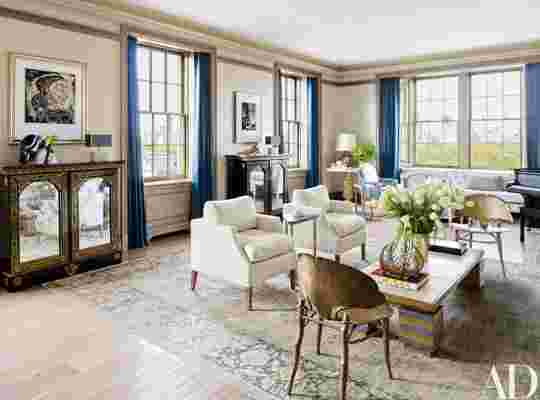Stephen Sills Restores a New York City Apartment to Its Original 1920s Glory
This article originally appeared in the October 2013 issue of Architectural Digest.
Set within a 1920s Italianate building on New York’s Fifth Avenue is a sprawling apartment renovated by interior designer Stephen Sills that appears to have been impeccably restored to its original glory, with ornate moldings, double-hung windows, and carved mantels. In fact, everything in the refined floor-through, which overlooks Central Park, is brand-new; it’s a streamlined modern space cloaked in stately splendor. “You think it’s an old apartment that’s been refurbished,” says Sills, “but this whole place was gutted, down to the concrete and pipes.” As architect John B. Murray , who collaborated closely with Sills, explains, “If you are going to put in state-of-the-art air conditioning, electronics, and lighting, all the walls and ceilings have to come down. At that point you might as well start from scratch.”
Though the overhaul came with a sense of responsibility to the space’s history, it was also an opportunity for the owners, an art-collecting couple with three children, and the outcome could have been quite different. During demolition, they flirted with a modernist fantasy. “I thought we could turn it into a loft,” says the wife. But the design team persuaded the couple to be true to the apartment’s DNA, reassuring them that the home could have an airy feel even when divided into traditional rooms. In the end they chose a classic layout and used unique architectural flourishes and special finishes to reinvigorate the concept of old-world grandeur. “We were looking to push the envelope without being trendy,” says the wife. “We entertain often, so we needed it to be glamorous, but we also wanted a real family apartment—the perfect combination of warmth and chic.”
The plan called for expansive walls to display the couple’s growing selection of modern and contemporary art. The owners also decreed that no piece of furniture should obstruct the panoramic views. “The main goal in decorating was to keep the sight lines clear,” says Sills, looking out from the living room’s windows at the park and the Metropolitan Museum of Art across the street, the buildings of the midtown skyline rising in the distance.



Done in a mix of bold and muted touches—Pop Art paintings, bleached wide-plank floors, a pair of Claude Lalanne bronze Ginkgo chairs, a faded Amritsar rug—the living room has an understated quality. “It’s Zenlike and peaceful,” says the wife. Many surfaces, including the trim and oak window frames, are gilded and glazed. “It gives the room life and shimmer,” says the designer, whose book Stephen Sills: Decoration (Rizzoli) comes out this fall. What elevates the space from sophisticated to sublime is the interplay between the entablature molding and the massive ’70s Roy Lichtenstein painting depicting a similar motif. “There is such beautiful connectivity between the art and the architecture,” says Murray, whose work is also the subject of a new monograph, Classical Invention: The Architecture of John B. Murray (The Monacelli Press).
Your comment